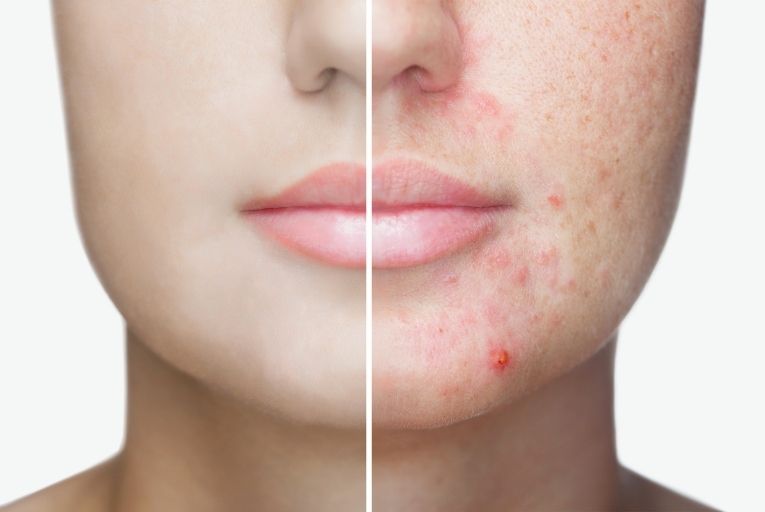Welcome to the first part of our guest posts on nutrition and the effect on the skin from Sophie Wedlock Smith owner of SWnutrition. Here we are discussing acne and the effects nutrition may have.
Acne is a chronic inflammatory condition characterized by papules (small red bumps that may be tender to touch), open comedones (blackheads), closed comedones (whiteheads), pustules (pus-filled lesions), nodules and cysts (pus-filled lesions deep in the skin)
It is estimated 9.4% of the global population have acne, making it the eighth-most prevalent disease worldwide.
What causes Acne?
Acne occurs when hair follicles plugged with oil and dead skin cells. The follicles are connected to sebaceous glands, which secrete sebum to lubricate your hair and skin. When your body produces an excess amount of sebum and dead skin cells, they build up within the hair follicle and form a soft plug, creating an environment where bacteria can thrive. Inflammation then results if the clogged pore becomes infected with bacteria.

The bacteria responsible for acne breakouts are called propionibacterium (P.acnes). They grow deep inside the hair follicle, where they feed on the sebum (their energy source). Most people with acne have an overgrowth of p.acnes bacteria in their skin.
The inflammation is caused not by the bacteria but by an immune response to the increased numbers of p.acnes as they multiply within the hair follicle. When your immune system is too active it sends out bacteria and this causes inflammation. The pus (whitehead) is simply a mix of dead skin cells and dead white blood cells. The progression of acne is often multifactorial and involves interplay between hormones, bacteria and inflammation.
Hormones and acne
Hormones play a major role in the development of acne. Androgens, the “male hormones” are present in women, the most well-known androgens being testosterone and its breakdown product dihydrotestosterone (DHT). We have androgen receptors at the base of the sebaceous gland and high levels of testosterone and DHT are capable of binding to these receptors, triggering the sebaceous gland to produce more sebum which in turn feeds the bacteria, subsequently leading to inflammation. High levels of estrogen can also contribute to the progression of acne.
Hormone balancing foods:
Clean protein; quinoa, lentils, eggs, oily fish.
Healthy fats; avocado, coconut oil, raw organic grass-fed butter, ghee, nuts and seeds.
Antioxidants rich foods; Kale, collards greens, chard, broccoli, red pepper, berries.
Glycemic load and acne
Insulin stimulates the sebaceous glands to produce more sebum. A diet of high sugar and carbohydrates leads to excessive levels of glucose in the bloodstream. This then leads to higher levels of insulin, which contributes to acne.
High Glycemic foods to avoid are: White potatoes, white bread, white pasta, pizza, dates, watermelon, rice cakes, white rice, fizzy sugary drinks, baked potato, ripened banana, raisins and honey.
Stress and acne
Cortisol, the stress hormone can contribute to acne flare-ups, as it is known to stimulate the production of sebum. It can also increase blood glucose levels, which can further exacerbate acne.
Dairy and acne
The content of hormones in cows milk can contribute to the development of acne. Milk also contains a growth factor (IGF-1) that can stimulate the sebaceous glands to produce more sebum, leading to the progression of acne lesions.
Opt for milk alternatives such as: Oat milk, almond milk, rice milk, coconut milk, hazelnut milk, quinoa milk.
Nutrition facts for acne
The link between nutrition and acne has been controversial, but recent research shows that diet can play a significant role in acne development.
Based on current evidence, dietary intervention has shown great promise in acne treatment.
- A diet for acne –free skin needs to provide carbohydrates with a low glycaemix index such as whole grains, brown rice, brown bread, rye, millet, bulgur, wheat.
- Reduce dairy consumption and try fortified plant milk instead. If your skin complaints continue to persist, consider eliminating allergens such as wheat, dairy and eggs.
- Include probiotic-rich foods such as kombucha, kimchi, sauerkraut, fermented tofu but not kefir because it is dairy based.
- Take a good quality and pure omega 3 supplement to support skin hydration and regulate the inflammatory response of the skin. Foods that are high in omega 3: Salmon, mackerel, anchovy, sardine, herring, flaxseed, seaweed.
- Considering supplementing with marine collagen, a natural source of type 1 collagen that is easily absorbed and provides great nutrition to acne prone skin. Consider organic produce wherever possible.
- Foods that help cure acne are rich in a variety of vegetables and (some) fruits of rainbow colours. Particularly green and orange ones for their carotenoid and polyphenol content.
- Include protein-rich foods because they support the growth and maintenance of collagen and elastin fibres. Amino acids proline and lysine work together with vitamin C to enhance the formation of collagen.
- Antioxidants rich foods will help neutralize inflammatory progression of acne. Both vitamin E and selenium have been shown to be effective in clearing acne. Resveratol, another potent antioxidant found in the skin of red grapes, (I’m not encouraging drinking of wine), mulberries, blueberries and nuts. It has been shown to destroy p.acnes bacteria.
- Green tea – Catechins, polyphenols found in green tea have anti-inflammatory effect on the sebaceous glands. They also have antibacterial properties and particularly target p.acnes. Furthermore, they reduce the conversion of testosterone to DHT, significantly reducing over production of sebum.
